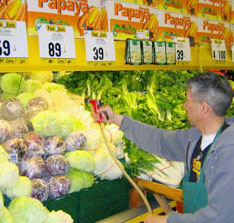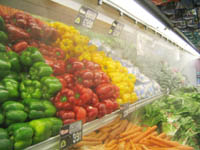19528 Ventura Blvd., Ste. 159
Tarzana, CA 91356
Phone (661) 755-3865

Ozone in air and water kills food pathogens in fresh perishable food applications such as fruits and vegetables. Bacteria, fungii, mold spores, and viruses reduce the product shelf life and pose significant product liability concerns. These spoilage organisms thrive and multiply faster at higher temperatures and high humidity. Many of these spoilage organisms and food pathogens will multiply even at lower temperatures during refrigeration. Most cross contamination occurs during cold storage. Proper treatment during processing, storage, and transport with ozonated water and/or air is the best means of safe, fresh produce with the greatest possible shelf life.
Depending upon particular needs, Produce Processors would choose our MD-1500 or MD-2000 systems to ensure freshness and safety from Farm-to-Table.

It is estimated that 30 million people a year get sick on what they consume and some even die as a result. Contamination Kills. If ozone was utilized by everyone on all food air and water applications from farm-to-table, the war on food pathogens would be making much greater progress. The scientific community agrees that Ozone treatment is the most effective natural bactericide of all the disinfecting or purification agents. It is considered to be the best available technology and a much better alternative than using chlorine for purification in food processing. When used in perishable food processing or cold storage produce treatment as an antimicrobial agent or as a food processing aid, it will benefit all perishables in all phases of food processing or preparation areas. Ozone disinfection will help prevent disease from food pathogens and enhance the quality of the working environment at the same time. A cleaner breathing environment raises worker productivity with fewer illnesses and fewer employee sick days.
Industry Report on Fruit & Vegetable Safety
Based on a paper presented at an annual meeting of the Institute of Food Technologists, this presents a review of the benefits of Ozone intervention in the fruit and vegetable processing industries. The dynamics of Ozone disinfection are presented, as well as an overview of Ozone applications within the industry. This paper also relates the benefits to be realized from Ozone water reclamation at food processing plants. It is estimated that the produce industry uses 50 billion gallons of fresh water each year, and Ozone remediation is the only obvious process capable of reducing this huge demand on our fresh water supply.
Industry Report on Postharvest Use of Ozone on Fruit
This article is from the Perishables Handling Quarterly professional journal. It generally focuses on comparisons of Ozone vs. hypochlorite treatments of postharvest fruit with a tabular comparison of the attributes of both disinfectants. A wide range of Ozone interventions are presented.
University of California Report on Postharvest Disinfection
This publication by the University of California at Davis provides a comprehensive review of the properties and uses of Ozone, as well as its regulatory status. Particular attention is given to the efficacy of Ozone when used on specific fruits and vegetables. Both gaseous and aqueous applications of Ozone are related.